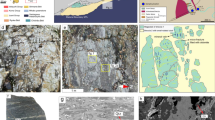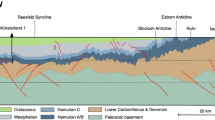Abstract
The Wenchuan earthquake occurred near the “triple junction” linking the Bayan Har block, the South China block, and the Sichuan-Yunnan rhombic block, and its influences on the surrounding blocks and the main fault zones in the Sichuan-Yunnan region, i.e., the block boundary zone, cannot be ignored. In this paper, changes of movement and stress of the fault zones before and after a strong earthquake were simulated based on the GPS repetition survey results recently obtained during 1999–2007, 2009–2011, and 2011–2013 with a two-dimensional finite-element contact model and the “block-loading” method. The results show that, before the Wenchuan earthquake, the movement of the Longmenshan fault zone was very slow and its compressive stress accumulated rapidly; after the Wenchuan earthquake, movements toward the E-SSE direction of the Bayan Har, southwestern Yunnan, and rhombic blocks were enhanced, and the dextral and horizontal compressive speeds and annual accumulative compressive stress of the Longmenshan fault zone increased markedly by factors of 4.5, 2.1, and 2.5, respectively. The southern Xianshuihe, Anninghe, Zemuhe, Daliangshan, and Lijiang-Xiaojinhe fault zones accumulated compressive stress rapidly, forming enhanced compressive stress zones along a NE strike crossing the central part of the Sichuan-Yunnan region. The tensional movement of the Xianshuihe fault zone was enhanced and the slip movement in the central part of the zone was reversed in a short time. The changes are tightly related to the medium-intensity earthquakes that occurred during the same period in this region, revealing that the spatial migration of seismic activity is related to changes of movement of the blocks.
Similar content being viewed by others
References
Bo W J, Xie J M, Guo L Q. 1998. Analysis and exploration of deformation of Babaoshan fault belt (in Chinese). Earthquake, 18: 63–6.
Cheng J, Xu X W, Gan W J, Ma W T, Chen W S, Zhang Y. 2012. Block model and dynamic implication from the earthquake activities and crustal motion in the southeastern margin of Tibetan Plateau (in Chinese). Chin J Geophys, 55: 1198–121.
Cheng W Z, Diao G L, LU Y P, Zhang Y J, Li G F, Chen T C. 2003. Focal mechanisms displacement rate and mode of the motion of the Sichuan- Yunnan block (in Chinese). Seismol Geol, 25: 71–8.
Ding K H, Xu C J, Zou R, Hu Y J. 2013. Crustal movement and strain model of active blocks analyzed by GPS in Sichuan-Yunnan region (in Chinese). Geomat Informat Sci Wuhan Univ, 38: 822–82.
Du F, Wen X Z, Zhang P Z, Wang Q L. 2009. Interseismic deformation across the Longmenshan fault zone before the 200. M8.0 Wenchuan earthquake. Chin J Geophys, 52: 2729–273.
Gan W J, Zhang P Z, Shen Z K, Niu Z J, Wang M, Wan Y G, Zhou D M, Cheng J. 2007. Present-day crustal motion within the Tibetan Plateau inferred from GPS measurements. J Geophys Res, 112. B08416, doi: 10.1029/2005JB004120
Guo S M, Ji F J, Xiang H F. 2001. The Red River Active Fault Zone (in Chinese). Beijing: Seismological Press. 1–l72
Jiang F Y, Zhu L Y, Wang S X, Zhang X L, Zhang X, Huang Z, Zheng S B. 2013. Research on characteristics of crustal block movement in Sichuan- Yunnan area (in Chinese). J Seismolog Res, 36: 263–26.
Kan R J, Zhang S C, Yan F T, Yu L S. 1997. Present tectonic stress field and its relation to the characteristics of recent tectonic activity in southwestern China (in Chinese). Chin J Geophys, 20: 96–10.
Li P, Wang L M. 1975. Exploration of the seismo-geological features of the Yunnan-west Sichuan region (in Chinese). Chin J Geol, 4: 317–32.
Li Y X, Li J L, Zhang J H, Guo L Q, Zhang Z F. 2007. The research progress in elastic plate motion model (in Chinese). Progr Geophys, 22: 1201–120.
Liang S M, Gan W J, Shen C Z, Xiao G R, Liu J, Chen W T, Ding X G, Zhou D M. 2013. Three-dimensional velocity field of present-day crustal motion of the Tibetan Plateau derived from GPS measurements. J Geophys Res, 118: 1–1.
Liu M, Yang Y Q. 2003. Extensional collapse of the Tibetan Plateau: Results of three-dimensional finite element modeling. J Geophys Res, 108(B8): 2361. doi: 10.1029/2002JB002248
Liu X, Ma J, Zhan W, Zhang F S, Liang F X, Fu R S. 2013. Crustal motion on Shanxi rift zone before and after Wenchuan earthquake (in Chinese). J Geodesy Geodynam, 33: 5–1.
Liu X, Sun D Y, Ma J, Lu J, Li A R, Liang F X, Zhan W. 2014. Present- day deformation and stress state of Longmenshan fault from GPS results-comparative research on active faults in Sichuan-Yunnan region (in Chinese). Chin J Geophys, 57: 1091–110.
Lü J N, Shen Z K, Wang M. 2003. Contemporary crustal deformation and active tectonic block model of the Sichuan-Yunnan region, China (in Chinese). Seismol Geol, 25: 543–55.
Qiao X J, Wang Q, Du R L. 2004. Characteristics of current crustal deformation of active blocks in the Sichuan-Yunnan region (in Chinese). Chin J Geophys, 47: 805–81.
Royden L H, Burchfiel B C, King R W, Wang E, Chen Z L, Shen F, Liu Y P. 1997. Surface deformation and lower crustal flow in eastern Tibet. Science, 276: 788–79.
Shan B, Xiong X, Zheng Y, Diao F Q. 2009. Stress changes on major faults caused by Mw7.9 Wenchuan earthquake, May 12. 2008. Sci China Ser D-Earth Sci, 52: 593–60.
Shan B, Xiong X, Zheng Y, Jin B K, Liu C L, Xie Z J, HSU H T. 2013. Stress changes on major faults caused by 201. Lushan earthquake and its relationship with 200. Wenchuan earthquake. Sci China Earth Sci, 56: 1169–117.
Shen Z K, Lu J N, Wang M, Burgmann R. 2005. Contemporary crustal deformation around the southeast borderland of the Tibetan Plateau. J Geophys Res, 110. B11409, doi: 10.1029/2004JB00342
Song F M, Wang Y P, Yu W X. 1998. The Xiaojiang Active Fault Zone (in Chinese). Beijing: Seismological Press. 209–232
Wang C Y, W.D.Mooney, Wang X L, Wu J P, Lou H, Wang F. 2002. Study on 3-D velocity structure of crust and upper mantle in Sichuan-Yunnan region, China (in Chinese). Acta Seismol Sin, 24: 1–1.
Wei W X, Jiang Z S, Wu Y Q, Zhao J. 2012. Study on the movement characteristics of the main fault zones on the eastern boundary of the Sichuan Yunnan Block using GPS data. J Wuhan Univ, 37: 1041–106.
Wan Y G, Shen Z K, Sheng S Z, Xu X F. 2009. The influence of 200. Wenchuan earthquake on surrounding faults (in Chinese). Acta Seismol Sin, 31: 128–13.
Wang Y Z, Wang E N, Shen Z K, Wang M, Gan W J, Qiao X J, Meng J G, Li T M, Tao W, Yang Y L, Cheng J, Li P. 2008. GPS-constrained inversion of present-day slip rates along major faults of the Sichuan- Yunnan region, China. Sci China Ser D-Earth Sci, 51: 1267–128.
Wu Y Q, Jiang Z S, Zhao J, Liu X X, Wei W X, Liu Q, Li Q, Zou Z Y, Zhang L. 2015. Crustal deformation before the 200. Wenchuan MS8.0 earthquake studied using GPS data. J Geodynam, 85: 11–2.
Xiang H F, Guo S M, Xu X W, Zhang W X. 2000. Active block division and present-day motion features of the south region of Sichuan-Yunnan province (in Chinese). Seismol Geol, 22: 253–26.
Xu X W, Wen X Z, Zheng R Z, Ma W T, Song F M, Yu G H. 2003. Pattern of latest tectonic motion and its dynamics for active blocks in Sichuan- Yunnan region, China (in Chinese). Sci China Ser D-Earth Sci, 33: 151–16.
Yunnan Earthquake Administration. 1998. The 199. Lijiang Earthquake (in Chinese). Beijing: Seismological Press. 188
Zhao J, Jiang Z S, Wu Y Q, Liu W X, Wei W X. 2011. Study on characteristics of block strain and faults deformation of Sichuan-Yunnan region before and after Wenchuan earthquake (in Chinese). J Geodesy Geodynam, 30: 30–3.
Zhang P Z, Xu X W, Wen X Z, Ran Y K. 2008. Silp rates and recurrence interval of the Longmenshan active fault zone, and tectonic implication for the mechanism of the May 1. Wenchuan earthquake, 2008. Sichuan, China (in Chinese). Chin J Geophys, 51: 1066–107.
Zhang P Z. 2008. The tectonic deformation, strain distribution and deep dynamic processes in the eastern margin of the Qinghai-Tibetan Plateau (in Chinese). Sci China Ser D-Earth Sci, 38: 1041–105.
Zhou R J, Li Y, Densomre A L, Michael A E. 2000. New Evidence for the Late Quaternary Tectonic Deformation on the Eastern Margin of the Tibetan Plateau. A Collection of Abstracts from Papers at the Eighth Symposium of the Seismological Society of China (in Chinese). Beijing: Seismological Press. 56
Zhu S B, Shi Y L. 2004. Genetic algorithm2finite element inversion of drag forces exerted by the lower crust on the upper crust in the Sichuan- Yunnan area (in Chinese). Chin J Geophys, 47: 232–23.
Zheng Y, Fu R S, Xiong X. 2006. Dynamic simulation of lithospheric evolution from the modern China mainland and its surrounding areas (in Chinese). Chin J Geophys, 49: 415–42.
Author information
Authors and Affiliations
Corresponding author
Rights and permissions
About this article
Cite this article
Liu, X., Ma, J., Du, X. et al. Recent movement changes of main fault zones in the Sichuan-Yunnan region and their relevance to seismic activity. Sci. China Earth Sci. 59, 1267–1282 (2016). https://doi.org/10.1007/s11430-016-5278-8
Received:
Accepted:
Published:
Issue Date:
DOI: https://doi.org/10.1007/s11430-016-5278-8




